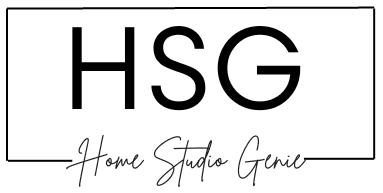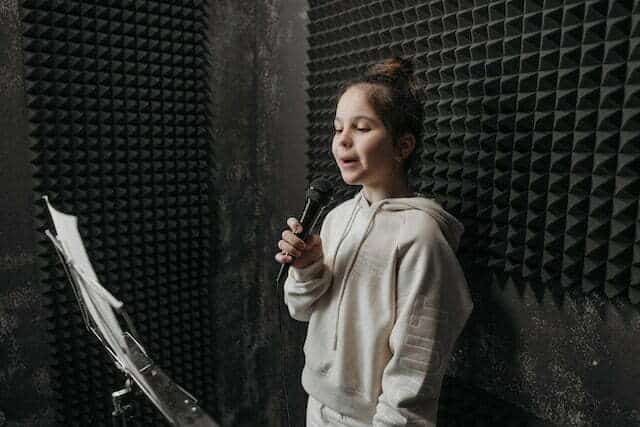Want to turn a spare room into a home music studio, but worried about how to soundproof it on a budget?
All you need is some careful planning and strategic use of affordable materials. You can then create an acoustically-treated space to record and mix music without spending a fortune.
Let’s jump in and find out how to soundproof your home studio on a budget.
Determine Your Soundproofing Needs
The first step is identifying the main goals for your soundproofing project. First off, consider the specific noises you want to reduce.
Are you trying to contain loud music within a room, or perhaps prevent external sounds from interfering with your recordings?

Understanding the nature of the noises you’re dealing with will guide you in finding the most effective solutions.
Next, think about the level of sound isolation you require. Achieving total acoustic isolation can be quite expensive. But you can still make significant strides in reducing noise.
Assess your needs and strike a balance between your desired level of sound isolation and your budget.
Is the space solely dedicated to music? If so, you have more extensive soundproofing options available to you.
Designating a dedicated area for music allows you to explore specialized techniques and materials to optimize the soundproofing.
Consider the size of the room or space you want to soundproof. Remember, the larger the area needing acoustic treatment, the higher the budget may be.
Understanding the dimensions of the space will help you plan and allocate your resources accordingly.
Consider these key questions:
- What noises need to be reduced? Are you trying to contain loud music, or prevent external sounds from interfering with recording?
- What level of sound isolation do you need? Total acoustic isolation is expensive, but you can still significantly reduce noise.
- Is it a dedicated space just for music? This allows more extensive soundproofing options.
- How large is the room? The bigger the area needing acoustic treatment, the higher the budget.
Once you’ve defined the soundproofing goals, you can choose affordable options that target the most pressing needs.
Plan the Room Layout First for Soundproofing Your Home Studio
Optimizing the room layout is an inexpensive way to improve sound isolation and quality.
Consider these tips:
- Place the home music studio away from noisy areas like streets. This reduces the amount of soundproofing required.
- Avoid shared walls, floors, and ceilings with other rooms if possible. Decoupled spaces are easier to soundproof.
- Use symmetry and simple rectangular room shapes for the most controlled acoustics.
- Face doors and windows away from noise sources. Keep them closed when recording.
- Position the mixing desk, studio monitors, and mics away from walls to reduce reflected sound.
Planning the layout carefully will reveal the most critical areas to treat for effective soundproofing.
Seal Air Gaps For a Soundproofed Home Studio
Even tiny gaps around doors, windows, electrical outlets, and recessed lights transmit considerable noise. Sealing air gaps is a simple, low-cost way to boost sound isolation.
- Install weatherstripping around doors and windows. Foam or rubber seals block noise leakage.
- Caulk and fill gaps in walls, floors, and ceilings with acoustical sealant. This impedes sound transfer.
- Add gaskets behind electrical outlets and light switch plates. Pliable materials block openings.
- Seal HVAC vents that connect to other rooms. Control sound traveling through ducts.
- Weatherstrip recessed lighting to contain noise. Caulk trim gaps for added protection.
- Hang a solid core door, sealed tightly. Hollow-core doors leak noise so it should be avoided.
Draft exclusion is an effective first step before installing more extensive treatments.
Add Mass Loaded Vinyl
Increasing mass is key for blocking sound transmission. Mass-loaded vinyl (MLV) is an affordable and easy way to add mass.
MLV is a thin, dense vinyl sheet containing barium salts or other mineral fillers. One pound per square foot can improve sound isolation.
Here are great uses for budget-friendly MLV:
- Line walls with 1-2 layers of MLV, adhered with construction adhesive.
- Overlap sheets to seal seams, and seal edges with acoustical caulk.
- Cut MLV 2” larger than ceiling dimensions. Affix over existing drywall or plaster.
- Adhere MLV liner behind acoustic panels, leaving an air gap. Doubles sound absorption.
- Use under carpet or floating floors as high-mass sound barrier.
With minimal thickness, MLV sheets offer substantial mass loading and noise blocking. Purchase sheets or rolls for simple DIY installation.
Insulate Walls and Ceilings
Sound leaks easily through poorly insulated cavities in walls and ceilings. Insulation muffles noise by absorbing vibrations and damping sound transmission.
Many common insulation materials provide acoustic benefits on a budget:
- Blown cellulose or fiberglass insulation fills wall/ceiling cavities. Use R-13 rating or higher for optimal sound blocking.
- Rockwool insulation batts are naturally sound-absorbent and work well in existing wall studs.
- Spray foam insulation adheres tightly to surfaces, sealing cracks and gaps that leak noise.
- Insulation fitted behind drywall improves isolation, especially for shared walls. Combine with MLV for added mass.
Proper installation is key. Seal edges with acoustical caulk and cover with rigid drywall to contain insulation. Using insulation improves noise control with minimal investment.
Install Acoustic Panels
Blank, flat walls, and ceilings reflect sound, creating problematic echoes and standing waves. Installing acoustic panels adds sound absorption to reduce reflections.
DIY acoustic panels are easy and affordable to make.
Basic panels consist of:
- Absorptive core material – fiberglass, rock wool, polyester insulation.
- Frame – plywood, lumber, PVC.
- Fabric cover – for appearance and core protection.
Panels can be hung on walls or ceilings using adhesive, Velcro, or simple brackets.
Effective placement includes:
- At reflection points between studio monitors and listening position.
- Along rear and side walls, spaced 2’-4’ apart.
- Ceiling corners and above mix/recording positions.
For targeted bass traps, make panels 4”-6” thick with rigid fiberglass or rock wool cores. The thick absorbers control low-frequency buildup.
With homemade panels from insulation outlet scraps or hardware store supplies, you can affordably treat key areas.
Decouple the Room to Soundproof Your Home Music Studio
Preventing noise flanking, or bending around barriers, is critical for effective soundproofing. Isolating the room using decoupling techniques limits sound transfer and resonance.
Some straightforward DIY decoupling solutions:
- Build a room within a room using double stud walls and floated internal ceilings.
- Install the studio on a basement or ground floor for physical separation.
- Use thick carpet or foam underlayment between floor joists as a floating floor.
- Hang the ceiling using resilient channels or clips to de-couple drywall.
- Apply Green Glue noise-proofing compound between wall layers to dampen vibration.
With air-gapped buffers and physical isolation, the studio space becomes much easier to soundproof within budget.
Final Touches for Optimizing Acoustics
Small upgrades and accessories can also enhance sound quality with minimal cost:
- Add thick curtains over windows and doors to absorb sound. Moving blankets work in a pinch.
- Caulk and seal HVAC ducts to prevent audio leakage.
- Position large bookshelves along walls to diffuse reflections.
- Angle studio monitors and speakers away from room boundaries.
- Cover bare floors with area rugs to dampen reflections and footsteps
Focus on merely enhancing the most problematic room acoustics. Avoid over-treating, as very “dead” rooms lose ambiance.
With research and strategic planning, nearly any room can become a great-sounding home music studio on a budget. Careful attention to layout, sealing leaks, adding mass, insulation, absorption, and isolation will maximize acoustic quality without the high costs.
Sources:
How to Soundproof a Home Studio for Recording
How to Soundproof a Room in Your Home Recording Studio

Mike is a skilled musician, guitar technician, and music producer with a passion for audio and gear. He excels in teaching guitar, editing podcasts/videos, and creating captivating soundscapes using cutting-edge hardware, software, and plugins. Mike’s talent and commitment make him highly sought-after in the industry, inspiring fellow musicians worldwide.


